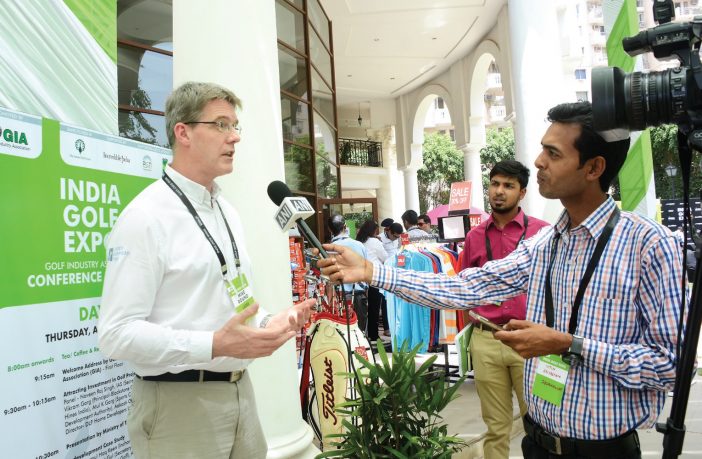Women’s participation is most vital for the growth of golf. They are the catalysts for bringing their families to the course, believes Mike Round, Director – Development, Ladies European Tour (LET). Mike on his maiden visit to the 6th India Golf Expo in Gurgaon illustrated the ways to generate interest among women, highlighted the importance of social media and revealed his intentions of bringing an LET Access Series event to the country. Excerpts from an interview…
GDI: How has the LET used social media to help raise awareness about the tour?
MR: We recognized the way society is going and a lot of people are consuming their information through digital channels, often into the palm of their hand or a handheld device. In terms of getting our message out to the consumers, the fans, the spectators, to anyone who is interested in women’s golf – we have to make sure that we are moving with the times. We have invested a lot of time and effort in the last two years in our digital output. We have got a member of staff who is dedicated to looking after our digital media channels and content, and we have seen a very significant increase in the number of followers on Facebook and Twitter and even number of views on Youtube. We have also started an alumni Facebook group which allows former members on the LET to connect with each other. This will help in business opportunities thereby growing the women’s game.
GDI: There are many innovations today in the men’s game – for instance, the Hero Challenge which is a one-hole shootout event. Has the LET considered such events to popularise the game amongst youngsters?
MR: We are in a slightly different position as compared to the men’s game. They have got a stronger schedule. Obviously, we are also looking to strengthen ours – we have got a core number of events at the moment. We are looking to enhance that so that we could also be creative and innovative. I guess one of the best examples of that is last year when we had a Wednesday finish with the Turkey event rather than the traditional Sunday finish. One of the ideas behind this was to finish when there is fewer sports coverage of other events that would give us increased visibility. I think the feedback made it a very successful exercise. This was looking at things in a slightly different way.
“Playing in Morocco alongside the men’s tour is good for us and the sport… Next year at Glasgow we have got the European Golf Championships with men’s and women’s competition staged together. This helps in increased visibility for women’s game.”
GDI: The European Tour and the LET both staged events recently during the same week for the first time in Morocco. Do you think this will break barriers?
MR: These kinds of things are a step in the right direction. Playing in Morocco alongside the men’s tour is good for us and the sport. We are seeing more and more of these mixed events coming up. Obviously, we have got the men and women competing at the Olympics as well – next year at Glasgow we have got the European Golf Championships where there will be a men’s competition, a women’s competition as well as a mixed competition. The direction of travel is clearly to see the opportunities for the men’s and women’s game to work together, being in the same place, joint initiatives – these sorts of things.
GDI: Do role models such as Aditi Ashok help in bringing new followers to the game?
MR: This is an interesting one, I think role models have their place. Aditi I think is absolutely fantastic for not only women’s golf in India but also for golf as a whole in the country. That is an essential part of the mix. However, you need to look at this holistically. There is no point in having a hundred different role models when people try to access the sport they find it too difficult, or its too expensive, or the product isn’t right and isn’t enjoyable. It is about having the right environment, having the right coaches to provide the right experience. These elements need to come together. This is why all of the bodies in the game need to come together and use their collective knowledge and expertise – which is in abundance in your country.
GDI: Should golf clubs drive more memberships for women golfers or should they work towards family clinics where they come along with their children and get introduced to the game?
MR: This process takes time. I think each individual club needs to look at its own operation and make an assessment of their own offers and experiences through the eyes of new beginners. Would it be attractive to them? I think the jump from being a non-golfer to becoming a golfer is a very big jump. It’s almost too big a jump to make on your own. I think you need to be helped through that process. The additional role of leaders and other organizers may well help to facilitate that. Often some clubs will have come up with very creative ideas when running the junior coaching programmes. Then they can also run adult programmes beside that. When people are dropping their children, they can have an experience as well. It does begin to build the experience for the family as a whole. Society has moved to families wanting to go out together. It’s not just the man who goes and spends some time at the golf club – like in the olden days. It’s good for golf to look outside the sport and see what the families do, where they go and what they enjoy doing together. There are ways in which we can create family experiences for golf. Driving ranges can be developed as places where they could practice together but there are also other opportunities like a cafe or a restaurant or other activities that can be built around them.
GDI: The LET has one event in India right now (Hero Women’s Indian Open). Would you think of staging lower prize money events on the LET Access Series in future?
MR: If the circumstances are right, yes. We are very very happy with the event that we have here in India. It’s a big country with a lot of people in it, and I am sure there’s scope for pushing that in the future. The Access series (the 2nd tier LET events) model is a good opportunity as it provides those who are considering whether or not they can make it as a tour professional, and it also gives the federation an opportunity to get used to sending their amateurs to different countries and get used to playing conditions there. Those tours are something that may well be of interest in other parts of the world. In Europe, the Access tour is serving a very big purpose, particularly in talent development.



